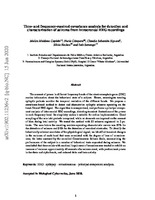Repositorio Digital
Time- and frequency-resolved covariance analysis for detection and characterization of seizures from intracraneal EEG recordings
JavaScript is disabled for your browser. Some features of this site may not work without it.
Mostrar el registro sencillo del ítem
| dc.contributor.author | Capitan, Melisa Maidana | |
| dc.contributor.author | Cámpora, Nuria | |
| dc.contributor.author | Sigvard, Claudio Sebastian | |
| dc.contributor.author | Kochen, Silvia | |
| dc.contributor.author | Samengo, Inés | |
| dc.date.accessioned | 2023-03-29T11:52:49Z | |
| dc.date.available | 2023-03-29T11:52:49Z | |
| dc.date.issued | 2020-06-15 | |
| dc.identifier.other | https://doi.org/10.48550/arXiv.1902.11236 | |
| dc.identifier.uri | http://repositorio.hospitalelcruce.org/xmlui/handle/123456789/1350 | |
| dc.description | Fil: Capitan, Melisa Maidana Instituto Balseiro and Departamento de Física Medica, Centro Atómico. Bariloche; Argentina | es |
| dc.description | Fil: Nuria Campora Consejo Nacional de Investigaciones Científicas y Técnicas; Argentina | es |
| dc.description | Fil: Sigvard, Claudio Sebastián Instituto Balseiro and Departamento de Física Medica, Centro Atómico. Bariloche; Argentina | es |
| dc.description | Fil: Kochen, Silvia Consejo Nacional de Investigaciones Científicas y Técnicas; Argentina | es |
| dc.description | Fil: Samengo, Inés Instituto Balseiro and Departamento de Física Medica, Centro Atómico. Bariloche; Argentina | es |
| dc.description.abstract | The amount of power in different frequency bands of the electroencephalogram (EEG) carries information about the behavioralstate of a subject. Hence, neurologists treating epileptic patients monitor the temporal evolution of the different bands. Wepropose a covariance-based method to detect and characterize epileptic seizures operating on the band-filtered EEG signal. Thealgorithm is unsupervised and performs a principal component analysis of intra-cranial EEG recordings, detecting transientfluctuations of the power in each frequency band. Its simplicity makes it suitable for online implementation. Good samplingof the non-ictal periods is required, while no demands are imposed on the amount of data during ictal activity. We tested themethod with 32 seizures registered in 5 patients. The area belowthe resulting receiver-operating characteristic curveswas 87%for the detection of seizures and 91% for the detection of recruited electrodes. To identify the behaviorally relevant correlatesof the physiological signal, we identified transient changes in the variance of each band that were correlated with the degree ofloss of consciousness, the latter assessed by the so-called Consciousness Seizure Scale, summarizing the performance of thesubject in a number of behavioral tests requested during seizures. We concluded that those crisis with maximal impairmentof consciousness tended to exhibit an increase in variance approximately 40 s after seizure onset, with predominant power inthe theta and alpha bands and reduced delta and beta activity. | es_AR |
| dc.language.iso | en | es_AR |
| dc.relation.ispartofseries | BIOLOGICAL CYBERNETICS. SPRINGER.;1 - 10 | |
| dc.subject | Epilepsy Syndrome | es_AR |
| dc.subject | Consciousnesses | es_AR |
| dc.subject | Electroencephalography | es_AR |
| dc.title | Time- and frequency-resolved covariance analysis for detection and characterization of seizures from intracraneal EEG recordings | es_AR |
| dc.type | Other | es_AR |

